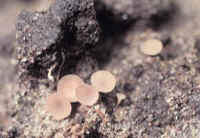Reports of Frogeye Leaf Spot in Soybean
Over the past week, we have had reports of Frogeye leaf spot in soybean. Frogeye leaf spot is caused by the fungus Cercospora sojina. DATCP noted finds of this disease in some fields in the southern part of the state. While Frogeye leaf spot has been documented in Wisconsin, it is still a disease that for many is a relative unknown. As you scout soybean fields late in the growing season, symptoms of Frogeye leaf spot can be recognized as angular, brown to reddish brown spots that are irregularly shaped and have a light brown to gray center. While lesions on stems and pod can occur later in the season they are less common and distinctive than lesions on the leaves. If there are pod infections, seeds near those lesions can be infected and develop conspcuous light to dark gray or brown areas.
Why 2010? The prolonged warmer, more humid and rainy periods we have seen this year are very favorable to development of this disease. Management recommendations for Frogeye Leaf Spot include the use of resistant soybean varieties, crop rotation that is 2 years or longer (the pathogen overwinters in soybean debris). Foliar fungicides can be effective for control of this disease, but timing of application is important.
For more information about Frogeye Leaf Spot, there are several good fact sheets like:
http://www.ces.purdue.edu/extmedia/BP/BP-131-W.pdf
http://www.soydiseases.illinois.edu/index.cfm?category=diseases&disease=119









